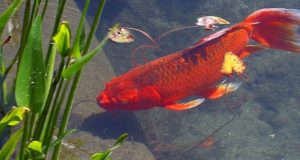Anyone who keeps a koi pond in cooler temperatures has been there. You start getting a few warmer days in late March and your koi, who had been inactive all winter, begin to swim around and look for food. Being the “good” koi keeper you are, and just an all around nice person, you start feeding your hungry friends almost immediately. The feeding continues to increase, while your pond continues to get greener. Meanwhile the local garden store is getting in a load of excellent looking Asagi or Shiro Utsuri Koi direct from Japan next week, and though you already have a questionable number of little Koi in your 1000 gallon pond, one more couldn’t hurt, right?
Pond keepers are creatures of extremes and it’s nothing we’re ready to apologize for (I mean, koi are soooo cool!). But, from a biological balance perspective, it’s really easy to start tipping the scale in your pond in favor of algae and unfavorable health conditions, particularly in the cooler weather.
Believe it or not, koi in an outdoor pond do not have to be fed to survive. Being the scavengers that they are, they’ll have no trouble finding the nutrients they need among the detritus, bugs, and general wild things that end up in your pond throughout the season. What this means to you is everything you add to the pond, whether it be more fish, fish food or plants, adds to the nutrient load. In early spring, this nutrient load is particularly important for several reasons. First, your beneficial bacteria are not yet running full steam. This means ammonia takes that much longer to break down. When you combine that with the fact that your fish, and their immune systems, are still in slow motion due to the cooler water temperatures, a high nutrient load can cause problems. In addition, the natural “nutrient sucker-uppers,” your aquatic plants, are also struggling to gain a hold for the new season, so that part of your natural filtration is crippled as well.
Many koi keepers than ask, how can I get around this problem? I love my pond and I’m not going to stop feeding my koi, and I’ll probably add more fish to the nutrient load from time to time because they’re too awesome to pass up. Our response to you: avoid the extremes. Be sure to have the necessary test kits on hand to make sure levels remain nominal throughout the season. If you start to see problems, just like in an aquarium, try a water change, or add some bottled bacteria to help the chemistry settle. If your pond starts to get cloudy or full of algae, try adding more plants, or cutting back a few feedings. If you’ve tried all of these solutions and the problems are not going away, it may be time to consider a larger filter system or (gasp!) trimming your koi stock a little.
Good luck with your pond this season!
 That Fish Blog – Aquarium Advice and Information
That Fish Blog – Aquarium Advice and Information


Thanks heaps for that! This makes a whole lot of sense! I have recently added more koi to my pond, but have frustratingly seen my pond turn green. As noted above it is possible to have a water change in your fish tank aquariums, but the best way unfortunately is to keep your koi numbers down!
Lol adding too much food in april!!!! i laughed about that because the pond is years old and has deep silt it it and 3 tons of weeds. there could even be a dead rabbit in there the fish would not be too worried! it is 300m2 and all the water is renewed every 10 15 days from a spring 🙂